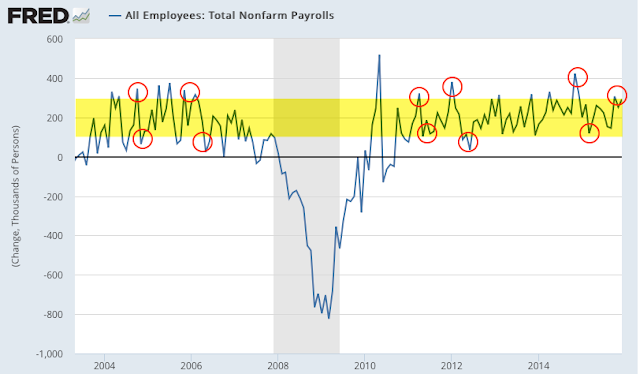Summary:
The balance of the macro data from the past month continues to be positive. To be sure, growth remains slow, but the balance of evidence suggests the imminent onset of a recession is unlikely.
The main positives are in employment, consumption growth and housing:
- Employment growth is close to the best since the 1990s, with an average monthly gain of 220,000 during the past year.
- Compensation growth is the highest in more than 6 years: 2.5% yoy in December.
- Most measures of demand show 3-4% nominal growth. Personal consumption growth the last fours quarters has been the highest in 8 years.
- New housing sales, starts and permits remain near an 8 year high.
The main negatives are concentrated in the manufacturing sector:
- Core durable goods growth fell 5% yoy in November. It was weak during the winter and there has been little rebound since. Industrial production has also been weak, falling -1.2% yoy.
- The core inflation rate remains under 2%, but note that CPI is beginning to tick higher.
Prior macro posts from the past year are
here.
* * *
Our key message over the past 2 years has been that (a)
growth is positive but modest, in the range of ~3-4% (nominal), and; (b) current growth is lower than in prior periods of economic expansion and a
return to 1980s or 1990s style growth does not appear likely.
Modest growth should not be a surprise. This is the
typical pattern in the years following a financial crisis like the one experienced in 2008-09.
This is germane to equity markets in that macro growth drives corporate revenue, profit expansion and valuation levels. The saying that "the stock market is not the economy" is true on a day to day or even month to month basis, but over time these two move together. When they diverge, it is normally a function of emotion, whether measured in valuation premiums/discounts or sentiment extremes.
Let's review each of these points in turn. We'll focus on four macro categories: labor market, inflation, end-demand and housing.
Employment and Wages
The December non-farm payroll was 292,000 new employees plus 50,000 in revisions. In the past 12 months, the
average gain in employment was 220,000. Gains in 2014 and 2015 are the highest since the 1990s.
Monthly NFP prints are normally volatile. Since 2004, NFP prints near 300,000 have been followed by ones near or under 100,000. That has been a pattern during every bull market; NFP was negative in 1993, 1995, 1996 and 1997. The low print of 119,000 in March, as well as the 'disappointingly weak' print in September, fit the historical pattern. This is normal, not unusual or unexpected.







